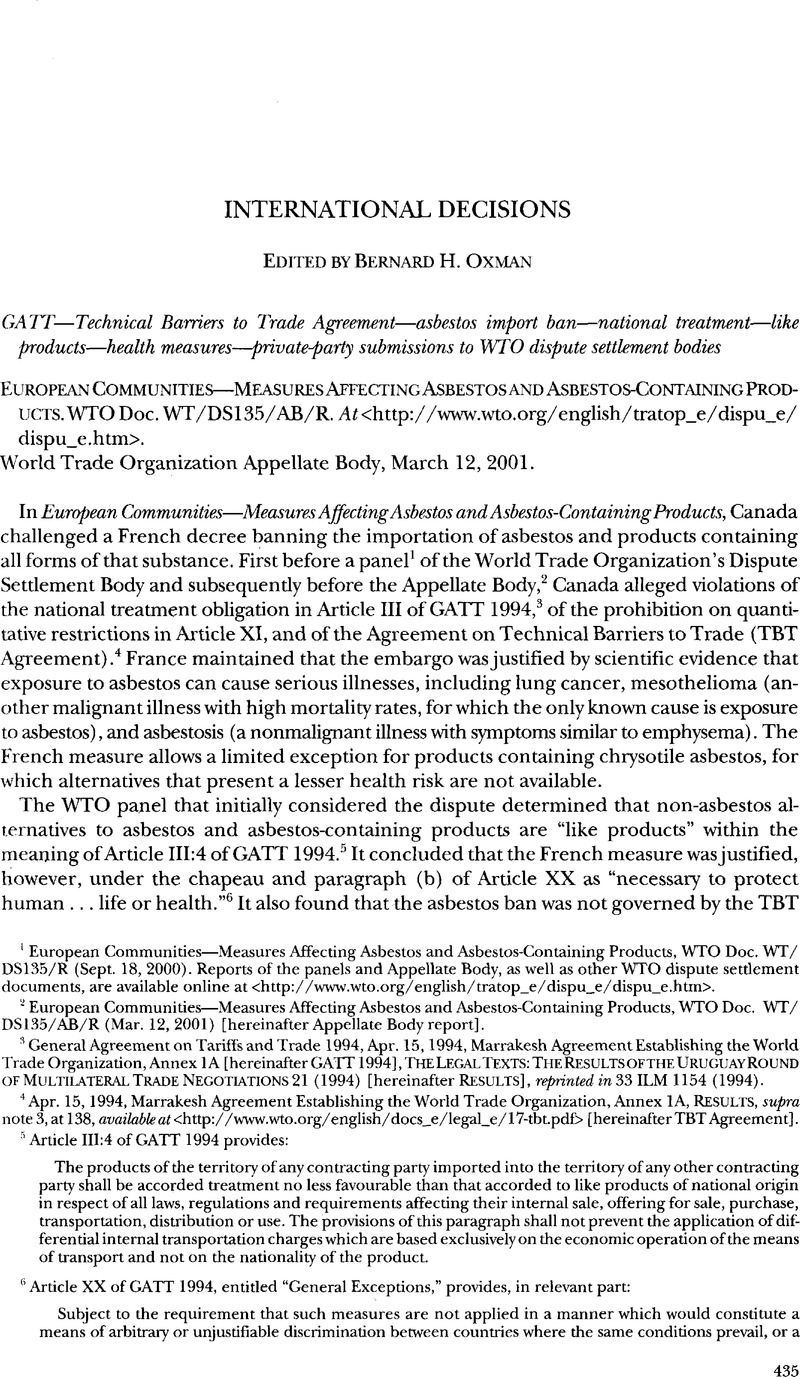No CrossRef data available.
Article contents
European Communities—Measures Affecting Asbestos and Asbestos-Containing Products
Published online by Cambridge University Press: 27 February 2017
Abstract

- Type
- International Decisions
- Information
- Copyright
- Copyright © American Society of International Law 2002
References
1 European Communities—Measures Affecting Asbestos and Asbestos-Containing Products, WTO Doc. WT/ DS135/R (Sept. 18, 2000). Reports of the panels and Appellate Body, as well as other WTO dispute settlement documents, are available online at <http://www.wto.org/english/tratop_e/dispu_e/dispu_e.htm>.
2 European Communities—Measures Affecting Asbestos and Asbestos-Containing Products, WTO Doc. WT/DS135/AB/R (Mar. 12, 2001) [hereinafter Appellate Body report].
3 General Agreement on Tariffs and Trade 1994, Apr. 15, 1994, Marrakesh Agreement Establishing the World Trade Organization, Annex 1A [hereinafter GATT 1994], The Legal Texts: The Results of the Uruguay Round of Multilateral Trade Negotiations 21 (1994) [hereinafter Results], reprinted in 33 ILM 1154 (1994).
4 Apr. 15, 1994, Marrakesh Agreement Establishing the World Trade Organization, Annex 1A, Results, supra note 3, at 138, available at <http://www.wto.org/english/docs_e/legal_e/17-tbt.pdf> [hereinafter TBT Agreement].
5 Article III:4 of GATT 1994 provides:
The products of the territory of any contracting party imported into the territory of any other contracting party shall be accorded treatment no less favourable than that accorded to like products of national origin in respect of all laws, regulations and requirements affecting their internal sale, offering for sale, purchase, transportation, distribution or use. The provisions of this paragraph shall not prevent the application of differential internal transportation charges which are based exclusively on the economic operation of the means of transport and not on the nationality of the product.
6 Article XX of GATT 1994, entitled “General Exceptions,” provides, in relevant part:
Subject to the requirement that such measures are not applied in a manner which would constitute a means of arbitrary or unjustifiable discrimination between countries where the same conditions prevail, or a disguised restriction on international trade, nothing in this Agreement shall be construed to prevent the adoption or enforcement by any contracting party of measures:
. . .
(b) necessary to protect human, animal or plant life or health[.]
7 The TBT Agreement applies to “technical regulations,” defined in Annex I of the Agreement as a “document which lays down product characteristics or their related processes and production methods, including the applicable administrative provisions, with which compliance is mandatory.”
8 See Appellate Body report, supra note 2, paras. 104-32.
9 “[A] Member may draw distinctions between products which have been found to be ‘like,’ without, for this reason alone, according to the group of ‘like’ imported products ‘less favourable treatment’ than that accorded to the group of ‘like’ domestic products.” Id., para. 100.
10 Dec. 2, 1970, GATT B.I.S.D. (18th Supp.) at 97 (1972).
11 Id., para. 114.
12 One of the three Appellate Body members hearing this appeal, not identified by name, made a concurring statement in which that member questioned the principally economic nature of the “likeness” test. In this member’s view, at least in this case in which the evidence is overwhelming, the carcinogenicity of asbestos itself would be sufficient to support a determination that that substance and alternatives to it are not “like.” Id., paras. 149-54.
13 Cf. European Communities—Measures Concerning Meat and Meat Products (Hormones), WTO Doc. WT/DS26/AB/R & WT/DS48/AB/R, para. 194 (Jan. 16, 1998); see generally A, David. Wirth, , Case Report: European Communities—Measures Concerning Meat and Meat Products, 92 AJIL 755 (1998)Google Scholar.
14 Appellate Body report, supra note 2, para. 178.
15 Id., paras. 82, 83. The Appellate Body has no authority to remand a dispute to a panel if it cannot complete the analysis itself based on the panel proceedings. See generally F, Andreas. Lowenfeld, , Remedies Along with Rights: Institutional Reform in the New GATT, 88 AJIL 477, 484 (1994)Google Scholar (noting that lack of remand authority “is understandable given the tight time constraints for the review process, but I cannot think of any analogous limitation in any multitiered system of legal decision making”).
16 Cf. United States—Import Prohibition of Certain Shrimp and Shrimp Products, WTO Doc. WT/DS58/AB/R (Oct. 12, 1998), reprinted in 38 ILM 118 (1999).
17 Appellate Body report, supra note 2, para. 52. Cf. SUP. CT. R. 37.1 (“An amicus curiae brief that brings to the attention of the Court relevant matter not already brought to its attention by the parties may be of considerable help to the Court. An amicus curiae brief that does not serve this purpose burdens the Court, and its filing is not favored.”).
18 Appellate Body report, supra note 2, para. 56.
19 See, e.g., Pruzin, Daniel & Menyasz, Peter, Safety and Health Environmental Groups Criticize WTO Ruling on Asbestos Ban, 17 Int’l Trade Rep. (BNA) 1432 (2000)Google Scholar.
20 See supra note 12. Separate opinions are unusual, if not previously unknown, in Appellate Body reports, a factor that itself tends to underscore the importance of the issue under consideration.
21 Appellate Body report, supra note 2, paras. 176-81.
22 Cf. Howse, Robert & Tuerk, Elisabeth, The WTO Impact on Internal Regulations: A Case Study of the Canada-EC Asbestos Dispute, in The Eu and The WTO: Constitutional and Legal Aspects 283, 328 (Grainne de Burca and Joanne Scott eds., 2001)Google Scholar (praising Appellate Body for “acting with judicial caution” and for “giving itself ample room to craft a balance between internal and external legitimacy appropriate to the factors of [future] cases”).
23 See generally David, A. Wirth, , Some Reflections on Turtles, Tuna, Dolphin, and Shrimp, 9 Y.B. Int’l Envtl. L. 40, 46–47 (1998)Google Scholar.
24 See WTO Doc. WT/GC/M/60, para. 120 (Jan. 23, 2001), at <http://docsonline.wto.org/gen_home.asp> (minutes of WTO General Council meeting of Nov. 22, 2001).


